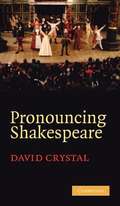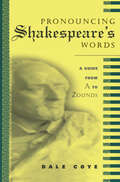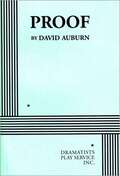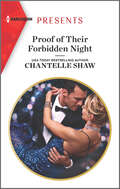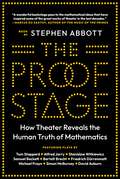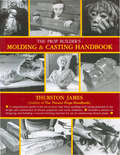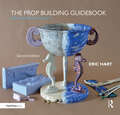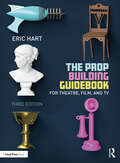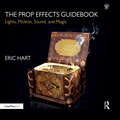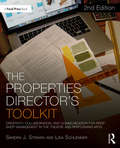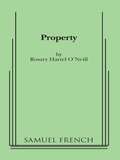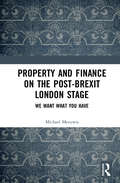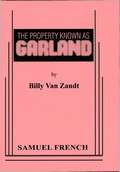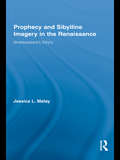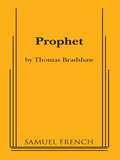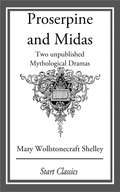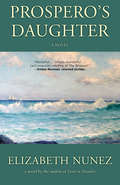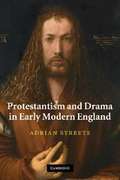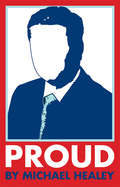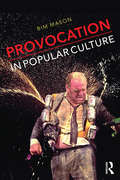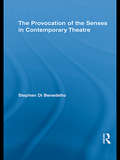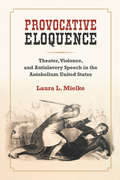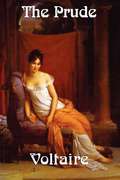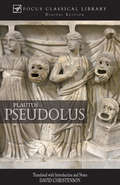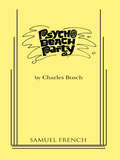- Table View
- List View
Pronouncing Shakespeare: The Globe Experiment
by David CrystalIn an unusual blend of autobiography, narrative, and academic content, reflecting the unique nature of the experience, David Crystal recounts the first attempt in over 50 years to mount a full-length Shakespeare play in original pronunciation.
Pronouncing Shakespeare's Words: A Guide From A To Zounds
by Dale CoyeFirst published in 2003. Routledge is an imprint of Taylor & Francis, an informa company.
Proof
by David AuburnOne of the most acclaimed plays of the 1999-2000 season, Proof is a work that explores the unknowability of love as much as it does the mysteries of science. <p><p> It focuses on Catherine, a young woman who has spent years caring for her father, Robert, a brilliant mathematician in his youth who was later unable to function without her help. His death has brought into her midst both her sister, Claire, who wants to take Catherine back to New York with her, and Hal, a former student of Catherine's father who hopes to find some hint of Robert's genius among his incoherent scribblings. <p><p> The passion that Hal feels for math both moves and angers Catherine, who, in her exhaustion, is torn between missing her father and resenting the great sacrifices she made for him. For Catherine has inherited at least a part of her father's brilliance -- and perhaps some of his instability as well. As she and Hal become attracted to each other, they push at the edges of each other's knowledge, considering not only the unpredictability of genius but also the human instinct toward love and trust.
Proof of Their Forbidden Night: Cinderella In The Sicilian's World / Proof Of Their Forbidden Night (Mills And Boon Modern Ser.)
by Chantelle ShawForbidden, seduced……pregnant with his baby!Greek CEO Andreas Karelis knows seducing innocent Isla Stanford would be a huge mistake—she’s completely off-limits! But thrown together on an Aegean island paradise, neither can resist indulging in their illicit temptation…Long after she leaves, their sizzling encounter is seared on to Isla’s heart—because she’s carrying Andreas’s heir! Scarred by her own father’s rejection, Isla is determined to make Andreas claim his son. Meaning she must face a terrifying truth—she wants Andreas to claim her, too…
The Proof Stage: How Theater Reveals the Human Truth of Mathematics
by Stephen AbbottHow playwrights from Alfred Jarry and Samuel Beckett to Tom Stoppard and Simon McBurney brought the power of abstract mathematics to the human stageThe discovery of alternate geometries, paradoxes of the infinite, incompleteness, and chaos theory revealed that, despite its reputation for certainty, mathematical truth is not immutable, perfect, or even perfectible. Beginning in the last century, a handful of adventurous playwrights took inspiration from the fractures of modern mathematics to expand their own artistic boundaries. Originating in the early avant-garde, mathematics-infused theater reached a popular apex in Tom Stoppard’s 1993 play Arcadia. In The Proof Stage, mathematician Stephen Abbott explores this unlikely collaboration of theater and mathematics. He probes the impact of mathematics on such influential writers as Alfred Jarry, Samuel Beckett, Bertolt Brecht, and Stoppard, and delves into the life and mathematics of Alan Turing as they are rendered onstage. The result is an unexpected story about the mutually illuminating relationship between proofs and plays—from Euclid and Euripides to Gödel and Godot.Theater is uniquely poised to discover the soulful, human truths embedded in the austere theorems of mathematics, but this is a difficult feat. It took Stoppard twenty-five years of experimenting with the creative possibilities of mathematics before he succeeded in making fractal geometry and chaos theory integral to Arcadia’s emotional arc. In addition to charting Stoppard’s journey, Abbott examines the post-Arcadia wave of ambitious works by Michael Frayn, David Auburn, Simon McBurney, Snoo Wilson, John Mighton, and others. Collectively, these gifted playwrights transform the great philosophical upheavals of mathematics into profound and sometimes poignant revelations about the human journey.
The Prop Builder's Molding & Casting Handbook (Technical Theatre, Film And Television Ser.)
by Thurston JamesThe Prop Builder's Molding & Casting Handbook This is the first book to contain, in one comprehensive volume, every molding and casting procedure of use to the theater props builder (no matter what his or her level or proficiency). The author demonstrates the techniques involved in using more than thirty different materials ranging from papier-mache to breakaway glass. While the use of some materials–plaster and polyester resins, for example–is covered to some extent in other publications, information on the selection and use of rubber materials (latex, neoprene, silicone, and the urethanes) and the procedure for making breakaway windows and bottles is available only in The Prop Builder's Molding & Casting Handbook. Written in an easy, conversational style, the book will be useful to anyone involved with theater properties, puppetry, and costuming (as professionals or amateurs). It will also serve admirably the needs of students taking classes in those subjects. Completing the book is a special section on designing and building a vacuum forming machine suitable for use in constructing theater props. More than 450 photographs illustrate the step-by-step procedures explained throughout the entire text.
The Prop Building Guidebook: For Theatre, Film, and TV
by Eric HartExperienced prop maker Eric Hart walks readers through techniques used in historical and contemporary prop making and demonstrates how to apply them to a variety of materials. Hundreds of full-color photographs illustrate the tools and techniques used by professional prop makers throughout the entertainment industry. New features to the second edition include: Updated information on the latest tools and materials used in prop making Both metric and standard measuring units Step-by-step photos on common techniques such as upholstery, mold making, and faux finishing Expanded coverage of thermoplastics, foam, and water-based coatings
The Prop Building Guidebook: For Theatre, Film, and TV
by Eric HartNow in its third edition, The Prop Building Guidebook: For Theatre, Film, and TV walks readers through techniques used in historical and contemporary prop making and demonstrates how to apply them to a variety of materials. Experienced prop maker Eric Hart covers the tools and techniques used by professional prop makers throughout the entertainment industry. He outlines a construction process that gives readers the foundational knowledge to choose the best materials and methods for each prop and the background information to know the advantages of these choices. This new edition includes updated information and techniques throughout, including: Over a hundred new images and diagrams Updated terminology, products, and brands used internationally Expanded sections on 3D printing, vacuum forming, foam patterning, and more A new chapter on prop design New information on international safety standards, cleaning, and sanitation More recipes and step-by-step instruction for various finishes Illustrated by hundreds of full-color photographs, this is the most comprehensive guide to prop construction available for professional and student prop makers in theatre, film, and tv. For additional how-to videos, instructional documents, and supplemental information, visit www.propbuildingguidebook.com.
The Prop Effects Guidebook: Lights, Motion, Sound, and Magic
by Eric HartIn The Prop Building Guidebook, author Eric Hart demonstrated how to cut, glue, sculpt, and bend raw materials to build props. Now in The Prop Effects Guidebook, he shows us how to connect and assemble components and parts to make those props light up, explode, make noise, and bleed. It delves into the world of electricity, pneumatics, liquids, and mechanical effects to teach you how to make your props perform magic in front of a live audience. The book is complemented by a companion website featuring videos of how to create individual prop special effects: www.propeffectsguidebook.com.
The Properties Director's Toolkit: Managing a Prop Shop for Theatre (The Focal Press Toolkit Series)
by Sandra Strawn Lisa SchlenkerThe Properties Director’s Toolkit is a concise guide to managing a prop shop and show build. Sandra Strawn and Lisa Schlenker skilfully explain and provide templates for organizing and managing a prop shop, from pre-production organization to production processes, budgeting and collaborations with other production areas. The Toolkit also explores how to plan, organize and maintain a prop shop for safe and efficient production work. This thoroughly revised second edition includes two additional chapters on the role of the Props Director and co-productions, along with expanding information in each chapter, including artisan responsibilities, union information, digital collaboration, prop shop organization and construction, and projections.
Property
by Rosary Hartel O'NeillFull Length, Southern ComedyCharacters: 2 male, 3 female. Unit set. Property is a contemporary romantic comedy set in a Garden District mansion in New Orleans. Rooster Dubonnet, a young artist suffering from a terminal disease, is dazzled by love. Raised by an imperious society-driven mother, he has fallen in love with a New-Age nurse. Set during Mardi Gras--when a whole tradition of fun, revelry, and prestige seizes the city-- Rooster is caught between his dedication to his family's past (and "property") and his own very different future. . Also available in Ghosts of New Orleans.
Property and Finance on the Post-Brexit London Stage: We Want What You Have
by Michael MeeuwisA guide to the contemporary London stage as well as an argument about its future, the book walks readers through the city’s performance spaces following the Brexit vote. Austerity-era London theatre is suffused with the belief that private ownership defines full citizenship, its perspective narrowing to what an affluent audience might find relatable. From pub theatres to the National, Michael Meeuwis reveals how what gets put on in London interacts with the daily life of the neighbourhoods in which they are set. This study addresses global theatregoers, as well as students and scholars across theatre and performance studies—particularly those interested in UK culture after Brexit, urban geography, class, and theatrical economics.
The Property Known As Garland
by Billy Van ZandtComedy / 1m, 1f / Interior / Her talent is legendary. Her wit, sublime. Her true story more electrifying than you'd ever imagine. She is Judy Garland. Adrienne Barbeau starred in this fictional backstage account of Judy's final concert appearance. With her wicked wit, Judy dishes the dirt on her co-stars, ex-husbands, Mr. Mayer, and more- taking us down the rocky yellow brick road of her incredible life. An amazing tour-de-force.
Prophecy and Sibylline Imagery in the Renaissance: Shakespeare’s Sibyls (Routledge Studies In Renaissance Literature And Culture Ser. #15)
by Jessica L. MalayThis book restores the rich tradition of the Sibyls to the position of prominence they once held in the culture and society of the English Renaissance. The sibyls — figures from classical antiquity — played important roles in literature, scholarship and art of the period, exerting a powerful authority due to their centuries-old connection to prophetic declamations of the coming of Christ and the Apocalypse. The identity of the sibyls, however, was not limited to this particular aspect of their fame, but contained a fluid multi-layering of meanings given their prominence in ancient Greek and Roman cultures, as well as the widespread dissemination of prophecies attributed the sibyls that circulated through the oral tradition. Sibylline prophecy of the Middle Ages served as another conduit through which sibylline authority, fame, and familiarity was transmitted and enhanced. Writers as disparate as John Foxe, John Dee, Thomas Churchyard, John Fletcher, Thomas Heywood, Jane Seager, John Lyly, An Collins, William Shakespeare, and many draw upon this shared sibylline tradition to produce particular and specific meanings in their writing. This book explores the many identities, the many faces, of the prophetic sibyls as they appear in the works of English Renaissance writers.
Prophet
by Thomas BradshawFull Length, Satire . Characters: 4 male, 3 female . Simple settings . A man wakes up one morning and decides he must kill himself. He is angry with himself for not hitting his wife every time she has an independent thought (as Abraham and Moses would have done). After she dies and God reveals to him that he is the new Prophet, the man takes a new wife, dresses her in slave chains, and begins to preach his newfound gospel of male domination. Simultaneously humorous and disturbing, Bradshaw's Prophet explores controversial issues in startling and unexpected ways. . "Fasten your seatbelts. PROPHET, Thomas Bradshaw's lacerating satire,...hurtles from rambunctious mockery to real horror. This is situation satire with a vengeance..."-The New York Times . This play contains scenes of a graphic sexual and violent nature that may not be suitable for all audiences.
Proserpine and Midas: Two unpublished Mythological Dramas
by Mary Wollstonecraft ShelleyMary Shelley (née Mary Wollstonecraft Godwin, often known as Mary Wollstonecraft Shelley) was a British novelist, short story writer, dramatist, essayist, biographer, travel writer, and editor of the works of her husband, Romantic poet and philosopher Percy Bysshe Shelley. She was the daughter of the political philosopher William Godwin and the writer, philosopher, and feminist Mary Wollstonecraft. Mary Shelley was taken seriously as a writer in her own lifetime, though reviewers often missed the political edge to her novels. After her death, however, she was chiefly remembered only as the wife of Percy Bysshe Shelley and as the author of Frankenstein. It was not until 1989, when Emily Sunstein published her prizewinning biography Mary Shelley: Romance and Reality, that a full-length scholarly biography analyzing all of Shelley's letters, journals, and works within their historical context was published. The well-meaning attempts of Mary Shelley's son and daughter-in-law to "Victorianise" her memory through the censoring of letters and biographical material contributed to a perception of Mary Shelley as a more conventional, less reformist figure than her works suggest. Her own timid omissions from Percy Shelley's works and her quiet avoidance of public controversy in the later years of her life added to this impression. The eclipse of Mary Shelley's reputation as a novelist and biographer meant that, until the last thirty years, most of her works remained out of print, obstructing a larger view of her achievement. She was seen as a one-novel author, if that. In recent decades, however, the republication of almost all her writings has stimulated a new recognition of its value. Her voracious reading habits and intensive study, revealed in her journals and letters and reflected in her works, is now better appreciated. Shelley's recognition of herself as an author has also been recognized; after Percy's death, she wrote about her authorial ambitions: "I think that I can maintain myself, and there is something inspiriting in the idea". Scholars now consider Mary Shelley to be a major Romantic figure, significant for her literary achievement and her political voice as a woman and a liberal.
Prospero's Daughter: A Novel
by Elizabeth NunezProspero's Daughter is a brilliantly conceived retelling of Shakespeare's The Tempest set in a remote corner of the author's native Trinidad during the height of tensions between Trinidadians and British Colonial rule. Above all, it is the story of a boy and a girl who form an unlikely and forbidden alliance to uncover a terrible secret.
Protestantism and Drama in Early Modern England
by Adrian StreeteContaining detailed readings of plays by Shakespeare, Marlowe and Middleton, as well as poetry and prose, this book provides a major historical and critical reassessment of the relationship between early modern Protestantism and drama. Examining the complex and painful shift from late Medieval religious culture to a society dominated by the ideas of the Reformers, Adrian Streete presents a fresh understanding of Reformed theology and the representation of early modern subjectivity. Through close analysis of major thinkers such as Augustine, William of Ockham, Erasmus, Luther and Calvin, the book argues for the profoundly Christological focus of Reformed theology and explores how this manifests itself in early modern drama. Moving beyond questions of authorial 'belief', Streete assesses Elizabethan and Jacobean drama's engagement with the challenges of the Reformation.
Proud
by Michael HealeyShortly after the Conservatives win a majority government in the 2011 federal election, the prime minister discovers a secret weapon in his caucus—Jisbella Lyth, a single mother with a limited understanding of her role as an MP. Using her ignorance to his advantage, the PM hatches a plan to have Jisbella front and centre in a campaign of misdirection and distraction. Humorous and clever, Proud explores the corrosive nature of the politics of division.
Provocation in Popular Culture
by Bim MasonWhat role can provocation play in the process of renewal, both of individuals and of societies? Provocation in Popular Culture is an investigation into the practice of specific provocateurs and the wider nature of cultural provocation, examining, among others: Banksy Sacha Baron Cohen Leo Bassi Pussy Riot Philippe Petit Archaos. Drawing on Bim Mason’s own twenty-five year career as performer, teacher and creative director, this book explores the power negotiations involved in the relationship between provocateur and provoked, and the implications of maintaining a position on the ‘edge’. Using neuroscience as a bridge, it proposes a similarity between complexity theory and cultural theories of play and risk. Three inter-related analogies for the ‘edge’ on which these performers operate – the fulcrum, the blade and the border – reveal the shifts between structure and fluidity, and the ways in which these can combine in a single moment.
The Provocation of the Senses in Contemporary Theatre (Routledge Advances In Theatre And Performance Studies #13)
by Stephen Di BenedettoDi Benedetto considers theatrical practice through the lens of contemporary neuroscientific discoveries in this provoking study, which lays the foundation for considering the physiological basis of the power of theatre practice to affect human behavior. He presents a basic summary of the ways that the senses function in relation to cognitive science and physiology, offering an overview of dominant trends of discussion on the realm of the senses in performance. Also presented are examples of how those ideas are illustrated in recent theatrical presentations, and how the different senses form the structure of a theatrical event. Di Benedetto concludes by suggesting the possible implications these neuroscientific ideas have upon our understanding of theatrical composition, audience response, and the generation of meaning.
Provocative Eloquence: Theater, Violence, and Antislavery Speech in the Antebellum United States
by Laura L MielkeIn the mid-19th century, rhetoric surrounding slavery was permeated by violence. Slavery’s defenders often used brute force to suppress opponents, and even those abolitionists dedicated to pacifism drew upon visions of widespread destruction. Provocative Eloquence recounts how the theater, long an arena for heightened eloquence and physical contest, proved terribly relevant in the lead up to the Civil War. As antislavery speech and open conflict intertwined, the nation became a stage. The book brings together notions of intertextuality and interperformativity to understand how the confluence of oratorical and theatrical practices in the antebellum period reflected the conflict over slavery and deeply influenced the language that barely contained that conflict. The book draws on a wide range of work in performance studies, theater history, black performance theory, oratorical studies, and literature and law to provide a new narrative of the interaction of oratorical, theatrical, and literary histories of the nineteenth-century U.S.
The Prude
by VoltaireThis comedy is partly imitated from an English piece, called the Plain Dealer. It does not suit very well for the French stage; the manners are too rough and bold, though much less so than in the original. The English seem to take too much liberty, and the French too little. -Voltaire Wilder Publications is a green publisher. All of our books are printed to order. This reduces waste and helps us keep prices low while greatly reducing our impact on the environment.
Pseudolus
by David Christenson PlautusThe play Pseudolus provides an introduction to the world of Roman comedy from one of its best practitioners, Plautus. As with all Focus translations, the emphasis is on an inexpensive, readable edition that is close to the original, with an extensive introduction, notes and appendices.
Psycho Beach Party
by Charles BuschImagine 'Gidget' crossed with 'The Three Faces of Eve' and 'Mommie Dearest'. Chicklet, a perky teenager in Malibu Beach circa 1962, wants to learn to surf and join a group of beach bums led by the great Kanaka. Unfortunately, she suffers from a multiple personality disorder. Seeing red causes her to transform into various other selves, including a sinister vamp out to conquer the world. Complications arise when a movie starlet flees the set of her latest rotten movie to hide among the surfers. The climax is a wild luau scene where hypnosis reveals the shocking root of Chicklet's psychosis.
